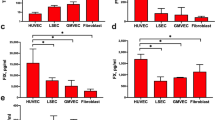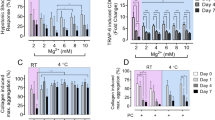Abstract
BLOOD removed from the circulation and allowed to clot undergoes retraction, and the evidence is quite conclusive that retraction requires the presence of viable platelets1,2. A circulating platelet is disk shaped, containing a marginal band of microtubules, a rather sparse layer of microfibres beneath the plasma membrane, and a variety of granules. With activation by clotting, the platelet peripheral microtubules disappear and hyaloplasmic microtubules appear, degranulation occurs, and the cells take on a constricted appearance because of the pseudopods that form and the centralizing of the organelles. The prevailing theory of clot retraction is that the withdrawal of the platelet pseudopods somehow provides the impetus for the compression of the inert extracellular fibrin. We suggested recently that in an analogous, non-mammalian clotting system the contraction of the whole haemostatic cell is related to clot contraction3.
This is a preview of subscription content, access via your institution
Access options
Subscribe to this journal
Receive 51 print issues and online access
$199.00 per year
only $3.90 per issue
Buy this article
- Purchase on Springer Link
- Instant access to full article PDF
Prices may be subject to local taxes which are calculated during checkout
Similar content being viewed by others
References
Budtz-Olsen, O. E., Clot Retraction (Thomas, Springfield, Illinois, 1950).
Luscher, E. F., in Blood Platelets (Henry Ford Symposium), 445 (Little, Brown, Boston, 1961).
Shepro, D., Belamarich, F. A., Merk, F. B., and Chao, F. C., J. Cell Sci. (in the press).
Bettex-Galland, M., and Luscher, E. F., Nature, 184, 276 (1959).
Malawista, S. E., and Bensch, K. G., Science, 156, 521 (1967).
Borisy, G. G., and Taylor, E. W., J. Cell Biol., 34, 525 (1967).
Inoue, S., in Primitive Motile Systems in Cell Biology (edit. by Allen, R. D., and Kamiya, N.), 549 (Academic Press, New York, 1964).
Warshaw, A. L., Laster, L., and Shulman, N. R., J. Biol. Chem., 242, 2094 (1967).
Borisy, G. G., J. Cell Biol., 34, 535 (1967).
Shelanski, M. L., and Taylor, E. W., J. Cell Biol., 34, 549 (1967).
Marsland, D., and Zimmerman, A. M., Exp. Cell Res., 38, 306 (1965).
Zucker-Franklin, D., J. Cell. Biol., 35, 149A (1967).
White, J. G., Amer. J. Pathol., 53, 281 (1968).
Author information
Authors and Affiliations
Rights and permissions
About this article
Cite this article
SHEPRO, D., BELAMARICH, F. & CHAO, F. Retardation of Clot Retraction after Incubation of Platelets with Colchicine and Heavy Water. Nature 221, 563–565 (1969). https://doi.org/10.1038/221563a0
Received:
Revised:
Issue Date:
DOI: https://doi.org/10.1038/221563a0
This article is cited by
-
Purification and partial characterization of an actin-like protein from cricket early egg plasmodium
Wilhelm Roux' Archiv f�r Entwicklungsmechanik der Organismen (1975)
Comments
By submitting a comment you agree to abide by our Terms and Community Guidelines. If you find something abusive or that does not comply with our terms or guidelines please flag it as inappropriate.



